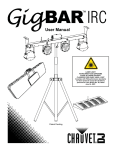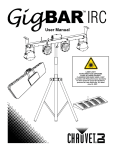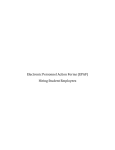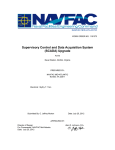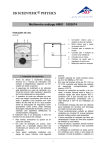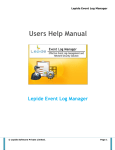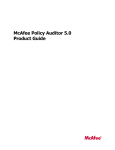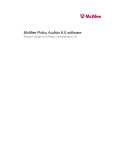Download Risk Reporter User Manual
Transcript
Risk Reporter User Manual Risk Reporter for PCI ACR 2 Solutions RISK ASSESSMENT – PCI User Manual v1 The information in this document is subject to change without notice. No part of this publication may be reproduced, stored, translated, or transmitted in any form or by any means electronic, mechanical, manual, optical, or otherwise, without the prior written permission of ACR 2 Solutions, Inc. ACR and ACR2 are trademarks of ACR 2 Solutions, Inc. The names of other companies and products are used herein for informational purposes only and are the trademarks of their respective companies. Risk Reporter for PCI User Manual 20090202 1 Table of Contents 1 INTRODUCTION ......................................................................................................................................... 3 1.1 TYPOGRAPHICAL CONVENTIONS ............................................................................................................ 3 2 RISK MANAGEMENT OVERVIEW ............................................................................................................ 4 3 THE RISK REPORTER ASSESSMENT PROCESS ................................................................................. 5 4 5 3.1 COLLECTING THE DATA.......................................................................................................................... 5 3.2 ACCESSING THE RR WEBSITE ............................................................................................................... 5 3.3 POLICY QUESTIONS ............................................................................................................................... 7 3.4 UTM DATA ............................................................................................................................................ 8 3.5 XCCDF UPLOAD ................................................................................................................................... 9 3.6 DATA REVIEW ........................................................................................................................................ 9 3.7 THE RESULTS ......................................................................................................................................10 APPLYING THE RISK ASSESSMENT ....................................................................................................12 4.1 CREATING AN ACTION PLAN.................................................................................................................12 4.2 CREATING AN UPDATE REPORT ...........................................................................................................13 CONTACT INFORMATION.......................................................................................................................16 5.1 TECHNICAL SUPPORT ..........................................................................................................................16 APPENDIX A – SAMPLE REPORTS ...............................................................................................................17 APPENDIX B – DEFICIENCY REPORT KEY ..................................................................................................22 APPENDIX C – GLOSSARY.............................................................................................................................23 Risk Reporter for PCI User Manual 20090202 2 1 Introduction Risk Reporter (RR) is an automated system designed to simplify the process of creating and updating risk assessments. Risk assessment is the initial step required by most information security regulations, , including the Payment Card Industry Data Security Standard (PCI DSS), the Gramm Leach Bliley Act (GLBA), the Health Insurance Portability and Accountability Act (HIPAA), the Federal Information Security Management Act (FISMA), and other state, federal, and international information security standards. This RISK ASSESSMENT – PCI version is designed around the protocols created by the PCI DSS and the United States National Institute of Standards and Technology (NIST). The PCI DSS mandates minimum standards of security from any organization that handles payment cards, while the NIST procedures are rapidly becoming a de-facto international standard. This widespread adoption is due to the security automation efforts of the US Department of Homeland Security under the Security Content Automation Program (SCAP). Automation of information security processes is essential for both adequate security and regulatory compliance. There are over 30,000 known vulnerabilities listed in the National Vulnerability Database (NVD), with more than 10 new vulnerabilities added daily. It is no longer practical to rely on general knowledge and manual checklists to secure an information system. 1.1 Typographical Conventions This document uses the following typographical conventions: • Command and option names appear in bold type in definitions and examples. • The names of directories, files, screens, and menus appear in “quotes”. • User inputted data appears bolded inside <angle brackets>. • Website addresses appear underlined. • Hyperlinks appear underlined and in blue font. • Notational usage information appears in indented and in italic type. Risk Reporter for PCI User Manual 20090202 3 2 Risk Management History and Overview Risk assessment is a process that was largely developed in the environmental industry in the 1970s and involves review of vulnerabilities, probability of damage, and the impact of damage. As the federal government and other regulators realized its enormous benefit of risk assessments, they mandated organizations in more industries to conduct them. In 2004, Visa, MasterCard, American Express, and Discover combined resources to create a single PCI Data Security Standard (DSS) with the goal of helping organizations protect customer information, safeguard transactions, and conduct risk assessments to identify vulnerabilities. The risk assessment process is continual; details of the DSS requirements vary according to the size of the organization, but in each case three steps are required: 1. Risk Assessment 2. Safeguards Implementation based on the risk assessment 3. Vulnerability Assessment to measure the effectiveness of the Safeguard Implementation As of June 2007, the DSS applies to every organization that processes payment card information, including merchants and third-party service providers that store, process, or transmit payment card data. Failure to comply with the Payment Card Industry security standards may result in heavy fines, restrictions, or permanent expulsion from card acceptance programs. Other industries also developed standardized risk assessment requirements. In 2002, the NIST produced a simplified risk assessment for use with “sensitive but unclassified” information. These risk assessments are mandatory for organizations regulated under FISMA, and are recommended for those regulated by GLBA and the Health Insurance Portability and Accountability Act (HIPAA). Risk Reporter assessment scores are calculated using the PCI DSS Requirement questions, Compensating Control (NIST Safeguard) questions, and UTM/configuration scan data. The risk management process continues to advance. Policy data and safeguards installations change at a slow rate, but network configurations may change daily and UTM data changes from minute to minute. Automated risk assessments, which automatically upload data from the UTM and network scans on a daily basis, are now possible. Policy changes may be added as they occur, creating the “near real-time” risk assessment that is the goal of NIST 800-39, the “flagship document of the NIST 800 series” (800-39, 42). Risk Reporter for PCI User Manual 20090202 4 3 The Risk Reporter Assessment Process Risk Reporter risk assessment software utilizes information from an organization’s existing Unified Threat Management (UTM) device/Intrusion Prevention System (IPS), Anti-Virus (AV) program, and a detailed NIST policy questionnaire to produce a quantitative, NIST compliant risk assessment[AKS1]. Assessed risk categories include Environmental, Human Error, Malicious Insider, and Malicious Outsider. Per the NIST 800-30 requirements, risks categories are rated from 1 to 100. 3.1 Collecting the Data To complete a risk assessment, you will need familiarity with and access to: • The organization’s Information Security Policy and Procedures • Information about personnel with access to protected data • The organization’s most recent SCAP scan file 3.2 Accessing the RR Website Browse to http://your_product_site[AKS2].net as shown in Figure 3.1. Enter the case-sensitive Username and Password (Serial Number) provided with the RR CD or in the welcome e-mail, then click the Login button. Note: For enhanced security, risk assessment sessions will timeout after 24 minutes on a single screen. Figure 3.1 Login screen Upon logging in, you will be directed to the Account Settings screen shown Figure 3.2. You must change your Username and Password before completing an assessment. Because login information may be e-mailed, it is not secure and cannot be used for data entry. You must also enter the email address at which you wish to receive the risk assessment reports. Risk Reporter for PCI User Manual 20090202 5 Figure 3.2 Account Settings After changing the account/verification information, you will need to login again, using the new information. The next step in the account creation process is industry selection, shown in Figure 3.3. This information will indicate the typical regulatory scheme to be considered in the assessment. While the overall risk assessment process is similar for a variety of regulations, there are differences in the details. Figure 3.3 Industry Selection After selecting your industry, you must select any additional regulations governing your organization’s risk assessment; verify that PCI DSS is selected. Figure 3.4 Regulation Selection Risk Reporter for PCI User Manual 20090202 6 After selecting the regulatory environment, you will see the Main Menu, Figure 3.5. Figure 3.5 Main Menu When you are ready to begin an assessment, return to the Main Menu and click the Start a New Baseline Assessment line. The Baseline is the first risk assessment of a calendar year; all updated assessments will be compared to this assessment. Before you can enter data, you must read and accept the Disclaimer, shown in Figure 3.6. RR is a repackaging of PCI DSS and/or NIST protocols, and is offered in good faith, but control over data entry is the responsibility of users; no warranty is offered or possible. Figure 3.6 Disclaimer Click the “I agree” button to bring up the first data entry screen. 3.3 Policy Questions The first questions section of the risk assessment pertains to the 203 questions in the 12 PCI security Requirements. The second section is a series of potential compensating controls taken from the 170 Security Control questions contained in the NIST risk assessment (800-39) and minimum safeguards (800-53) protocols. Answer each question by selecting the most appropriate choice from the pull-down menu. The options are No - the safeguard is not in place or functioning, Yes - the safeguard is in place and functioning, or NA - the safeguard does not apply at this location. The default answer for each question is No, the most conservative answer. Figure 3.7 Sample PCI Question Risk Reporter for PCI User Manual 20090202 7 The language of the Compensating Controls is a plain English paraphrase of the original wording. To view the original wording for any NIST safeguard, click Official Language at the end of the paraphrase. The paraphrase and official language for question AC-1 is shown below. Figure 3.8 Sample Compensating Control Question After answering the last question in a section, click the Save and Continue button to update the next data section. This is a secure transmission and may take up to a minute to load; do not press the button more than once. To update a different data section, use the navigation buttons or the pull down menu. Note: Using any navigation tool will result in the loss of data inputted into the section. To save changes, click the Save and Continue button. Depending upon your familiarity with your organization’s Information Security Policy and Procedures, completing a risk assessment may take as few as three hours. However, assessments do not need to be completed in a single sitting. To interrupt a data session, use the Log Out line in the menu box of each data screen. When you log back in, an option to Find and Complete Assessments will appear in the Main Menu. Selecting an incomplete assessment brings up the Review screen shown in Figure 3.11; click any section to load that data entry page. This selection is also a secure transmission and may take up to a minute to load. 3.4 UTM Data This data section is different from the others. As shown in Figure 3.9, it requires numerical, UTM/IPS, and AV data. Risk Reporter for PCI User Manual 20090202 8 Figure 3.9 UTM Data Section 3.5 XCCDF Upload This data section requires you to upload the organization’s most recent SCAP scan. Figure 3.10 XCCDF Upload Section 3.6 Data Review The final section is the Review Screen. Once all of the sections have been updated, the Finalize button becomes active, as shown in Figure 3.11, and a Baseline Report can be generated. Risk Reporter for PCI User Manual 20090202 9 Figure 3.11 Review Section There are several ways to review your answers before submitting an assessment. Click a blue section link or use the pull-down menu to navigate back to the desired control section, or click the Review All Answers line above the Finalize button. As shown in Figure 3.12, this will bring up a summary of your answers. Figure 3.12 Quick Review 3.7 The Results RR reports are designed to help organizations efficiently prioritize and organize safeguards which must be put into place or updated. The risk assessment data will generate two reports, a Baseline Report and a Chart Report. These locked reports are e-mailed to the account that was specified during the account creation process, and require your account password to open. Two additional reports, the PCI Inventory Report and the PCI Gap Report accessible from the Main Menu, are also generated. Note: Access to e-mailed reports requires the installation of Adobe® Acrobat Reader® Version 6.0 or newer. See Appendix A for report samples. Risk Reporter for PCI User Manual 20090202 10 1. baseline.pdf - a numerical scoring of risks to information security and availability. Risks are defined as threat source/vulnerability combinations, and are divided into 30 risk categories based on the NIST protocols. Risks range from E1, wind/roof damage, to MO8, malicious outsider/internal controls. The Baseline Report is the first report generated in the year and cannot be altered; future assessments will generate an Update Report (update.pdf). When compared to update reports, the Baseline enables you to determine the degree of change in the organization’s risk scores. 2. chart.pdf - a graphical, color coded representation of the baseline or update risk scores. Red/yellow/green coding indicates high, medium, and low risk status, respectively. 3. PCI Inventory Report - an overview listing the answers to each question in the most recent risk assessment. Information from all data entry sections is included. 4. PCI Gap Report - a detailed list of missing or underperforming safeguards, which have negatively affected the most recent risk assessment. Holding the cursor over each safeguard gives more information about the threat source and affected vulnerability. These reports enable user to create an Action Plan for the organization. Low, Medium, and High likelihoods of adverse events are scored at 0.1, 0.5, or 1.0, respectively. In the same manner, Low, Medium, and High impacts are scored at 10, 50, and 100 respectively. A risk score, from 1 (low) to 100 (high) is calculated by multiplying the likelihood score and the impact score. According to NIST standards, risks scores >50 require immediate action, risks scores from 10 to 50 need to be scheduled for management, and risks <10 can be monitored without further action. Risk Reporter for PCI User Manual 20090202 11 4 Applying the Risk Assessment Compliance is a continuously moving target; conducting a risk assessment is only part of the risk management process. Regulated firms are required to 1. Assess risks 2. Install Safeguards 3. Test Safeguard effectiveness 4. Re-assess risks Data from a network scan (800-30 section 3.1), IPS data, Antivirus data (Section 3.3), and policy data are input into the Risk Engine. This creates the Results Documentation (Section 3.9) and recommendations for change. The changes in Controls are implemented and the changes added to the risk engine, along with updated Scan, IPS, and AV data. This cycle can be done as often as daily, with reports on demand. The risk management process is an ongoing cycle that will continue as long as the organization remains in operation. 4.1 Creating an Action Plan Following the review and acceptance of these risk reports by management, it is necessary to create an action plan. The plan should prioritize the needed safeguards in order to increase or maintain compliance with information security regulations. You may find the PCI Inventory Report and PCI Gap report (accessible from the Main Menu) useful for quickly determining which areas are in need of improvement. The Inventory Report provides a summary of every answer inputted for the most recent assessment, while the Gap Report shows which safeguards negatively affected the assessment. Once you have identified the needed safeguards, they can be listed using data from the Deficiency Report Key in Appendix B. In most cases, the Action Plan will address upgrades in order of cost and convenience. Many changes are inexpensive and demonstrate progress to regulators without major cost, but other changes may require capital planning before being phased in. For example, safeguard SI-5, Security Alerts and Advisories, is easy to update. A number of free websites can fill this need, including several government sites such as Computer Emergency Readiness Team (CERT). On the other hand, CP-2, which requires the creation of a NIST compliant Contingency Plan, can be a major effort. Once the action plan for red risks is in place, implement a similar program for yellow risks. Under NIST guidelines, risks in the yellow range need to be "scheduled for remediation". Again, the fastest and least expensive rule of prioritization is a prudent use of limited corporate resources. On a weekly basis, as new safeguards are implemented, the risk assessment can be updated with new reports. At a minimum, a monthly reassessment of risk is recommended, and should be placed in the appropriate portion of the organization’s Information Security Plan notebook. Compliance regulators do not expect organizations to be perfectly secure. However, "reasonable and appropriate" progress is not only expected, but required. Periodic, quantitative risk assessment reports can provide a low cost means of documenting the organization's compliance level. Risk Reporter for PCI User Manual 20090202 12 4.2 Creating an Update Report Creating an update report is easy. Login to an account that has had a baseline report issued within the last 12 months and select Find and Complete Assessments, as shown in Figure 4.1. Figure 4.1 Main Menu As with the Baseline report, data entry sections begin after the disclaimer is accepted; use the pull down menu to change the assessment as needed. Once you have made any known changes, check the Review page to determine if additional input is required. From time to time the PCI DSS and NIST update the controls. When that occurs, you will see Questions not reviewed. You must answer these questions before an update report can be issued. Additionally, because the security questions are interrelated, RR software analyzes the changes made to data sections and recommends additional changes via a notification message on the review screen. To view the suggested changes, select Click Here as shown in Figure 4.2. Figure 4.2 Suggested Answers Notification Clicking the link will provide additional information about affected questions, as shown in Figure 4.3. Figure 4.3 Suggested Changes Risk Reporter for PCI User Manual 20090202 13 After you have generated a Baseline report, the Main Menu option to Show Report History will become active. This feature is most useful after you have generated multiple reports; it allows you to determine what input changed between assessments, and thus, which policies and procedures, scan, or upload changes affected the risk score. Figure 4.4 shows an increased risk to E6. Figure 4.4 Multi-Report Overview Click GO! to view the data submitted for each assessment. As shown in Figure 4.5, this screen gives a summary of the data submitted for each report. Risk Reporter for PCI User Manual 20090202 14 Figure 4.5 Report Detail In order to compare differences between assessments more easily, you may also wish to view the reports that were generated from an earlier assessment. From the Main Menu, select Request a Copy of a Previous Assessment. As shown in Figure 4.6, this will allow you to select an assessment and receive, via locked, PDF reports, the reports it generated. Figure 4.6 Request a Report Copy Risk Reporter for PCI User Manual 20090202 15 5 Contact Information Thank you for your interest in Risk Reporter. For general information, contact Sales Rep: E-mail: [email protected] Phone: 1. 678-261-8181 5.1 Technical Support Technical support for RR is available 8 hours a day, 5 days a week. Please review the appropriate section of the manual before contacting technical support. If the problem persists email [email protected] When contacting support, please have the following information available: • • The version of Risk Reporter software you are using The computer’s browser and operating system version Risk Reporter for PCI User Manual 20090202 16 Appendix A – Sample Reports Baseline Report Risk Reporter for PCI User Manual 20090202 17 Update Report Risk Reporter for PCI User Manual 20090202 18 Chart Report Risk Reporter for PCI User Manual 20090202 19 Inventory Report Risk Reporter for PCI User Manual 20090202 20 Gap Report Risk Reporter for PCI User Manual 20090202 21 Appendix B – Deficiency Report Key Label Threat Source Vulnerability E1 Wind Roof Damage E2 Fire Smoke Damage E3 Flood Facility Damage E4 Power Loss Loss of Operations E5 Power Loss Damage to Building E6 Vehicle Collision Facility Damage HE1 Human Error Data Acquisition HE2 Human Error Data Storage HE3 Human Error Data Retrieval HE4 Human Error Data Modification HE5 Human Error Data Transmission HE6 Human Error System Design HE7 Human Error Procedure Implementation HE8 Human Error Internal Controls MI1 Malicious Insider Data Acquisition MI2 Malicious Insider Data Storage MI3 Malicious Insider Data Retrieval MI4 Malicious Insider Data Modification MI5 Malicious Insider Data Transmission MI6 Malicious Insider System Design MI7 Malicious Insider Procedure Implementation MI8 Malicious Insider Internal Controls MO1 Malicious Outsider Data Acquisition MO2 Malicious Outsider Data Storage MO3 Malicious Outsider Data Retrieval MO4 Malicious Outsider Data Modification MO5 Malicious Outsider Data Transmission MO6 Malicious Outsider System Design MO7 Malicious Outsider Procedure Implementation MO8 Malicious Outsider Internal Controls Risk Reporter for PCI User Manual 20090202 22 Appendix C – Glossary Term Meaning Action Plan A plan to prioritize and upgrade system safeguards to maintain or increase compliance. Administrative Account An account with administrative permissions to one or more systems on a network. Administrative Scan Account Administrators may create these accounts specifically for the purpose of conducting ThreatGuard Scans. More complex networks may require the creation of several accounts. Baseline Report The first risk assessment of a calendar year. This contains a numerical scoring of risks to information security and availability. All future risk assessments will be compared to the Baseline report. Chart Report A graphical, color coded representation of the baseline or update risk scores. Compensating Control Compensating controls may be considered when an entity cannot meet a requirement explicitly as stated, due to legitimate technical or documented business constraints but has sufficiently mitigated the risk associated with the requirement through implementation of other controls. Compliance Officer The individual responsible for conducting the risk assessment. Deficiency Report A cross listing of missing or underperforming safeguards. Federal Enterprise Architecture (FEA) A business-based framework for government-wide improvement developed by the OMB. It is intended to ease efforts to move the federal government toward becoming citizen-centered, results-oriented, and market-based. Gap Report A chart indicating “gaps” in security compliance. This report specifies which questions/factors negatively impacted the Risk Assessment score. Group CEOs, Managers, etc. who are responsible for maintaining security compliance. Hub A device used to connect multiple networking cables together to make them act as one unit. Hyperlink (link) Clickable text or graphics that direct the user to another document (typically a website) or to another place within the same document. Internal Network The client’s network. Intrusion Detection System (IDS) Software or hardware that detects attacks on a computer or network, but is incapable of stopping data damage or retrieval. Risk Reporter for PCI User Manual 20090202 23 Intrusion Prevention System (IPS) Software or hardware that is capable of real-time prevention of an attack on a computer or network. Isolated Network Internal ACR 2 network. Magnus Navigator The client application that is used to configure and manage the Secutor Magnus server. Network Administrator The individual responsible for installing the system. This individual manages the local area communications network within an organization and, traditionally, is responsible for the configuration, maintenance, day-to-day operations, and installation of infrastructure components. Network Address Translation The process of passing network traffic through a router that re-writes the source and/or destination IP addresses. Risk The likelihood that a vulnerability will be exploited, modified by the impact of the exploitation. Risk Score Change Risk Scores may change due to changes in the safeguards an organization uses or because of safeguard performance. Router A computer that is configured to route and forward information. Software as a Service (SaaS) A sales model whereby access to the software application is hosted by the seller and the user is provided access via the Internet. Status Report A compilation of the current status of the safeguards for the information system. Substantial Compliance Several aspects of security compliance are covered in each question. If a majority of aspects are in place, the group is considered to be in substantial compliance and may answer “Yes” to the question. System Logging (Syslog) The transmittal of event messages and alerts across an IP network. Messages are sent by the operating system or application to report the current status of a process. Unified Threat Management (UTM) UTM is used to describe network firewalls that have many features in one box, including e-mail spam filtering, anti-virus capability, an intrusion detection (or prevention) system (IDS or IPS), and World Wide Web content filtering, along with the traditional activities of a firewall. Update Report Any report made after the Baseline report. Determines the degree of increase or decrease in compliance compared to the baseline. Update risk assessments are required after system changes. Vulnerability Areas where security is weak and is at risk of being exploited. 20081106 Risk Reporter for PCI User Manual 20090202 24


























